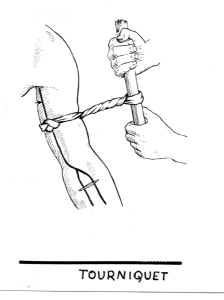 Injury is not something anyone likes to deal with. However, they happen and you need to know how to save the life of a loved one. Extremity bleeding can quickly cause shock and death. When pressure bandages and pressure points fail to control bleeding, another option is available.
Injury is not something anyone likes to deal with. However, they happen and you need to know how to save the life of a loved one. Extremity bleeding can quickly cause shock and death. When pressure bandages and pressure points fail to control bleeding, another option is available.
The Tourniquet
In last year’s article by Dr. David Johnson, writer for Wilderness Medical Association and an ER Physician, he touched on some debated facts and cleared up some myths based on recent proof of use:
In civilian practice, it is relatively rare for death from limb bleeding to occur because properly applied, well-aimed direct pressure failed. Still, tourniquets have their use outside of theater (e.g., mass casualty), so knowing how to use one is important. The relevant questions include what, where and for how long.’
That’s what I intend to do for you – explain the what, where, and how long. It’s important that you know how to use a tourniquet, and the proper usage so you don’t lose an arm!
How to Improvise
There are many first aid products you can buy to keep in your survival gear for the purpose of stemming major bleeding. And it would be wise to have a variety of options for each individual in your party.
If you lack one of these devices or they aren’t working well enough and find yourself unable to stop a major bleeding episode, here is how to improvise your own tourniquet:
- Use something firm but soft. A shirt or belt can work well.
- The material needs to be long enough to wrap around the appendage several times.
- Fold in about a two-inch band (approximately 2-3 fingers wide) and keep the material smooth and flat to prevent pinching of the skin.
- A ridged stick – used to tighten the tourniquet – is needed that won’t break or loosen.
Using the Materials
Panic is heightened. Fear runs in you and the injured. You have the pieces you need to make a tourniquet, but now what?
- 3-4 fingers upstream from the injury is the best site to apply the tourniquet.
- The site needs to be padded or at least the spot directly under the knot. Keep clothing over the site if at all possible; otherwise make sure the improvised tourniquet material is as smooth as possible.
- Make a half-knot and place the stick over it and complete the other half not over top of it.
- Turn the stick, increasing pressure, until all the bright red blood has stopped. Oozing may still occur, but this can be controlled. NEVER OVER TIGHTEN!
- Take the remaining material and knot the stick down to the appendage so as it cannot come unwound, but could be released if necessary. Leave the tourniquet completely exposed.
- Mark a “T” on the victim’s forehead with the time if possible.
Complications of Tourniquet Use …
Nothing is guaranteed to be 100% accurate and perfect. A tourniquet can cause:
- Skin and muscle damage
- Nervous tissue damage
- Loss of the appendage
The upside to the downside is, tourniquets save lives. They are even used in knee surgeries for extended lengths of time with no damage to the application site.
To Remove, or Not Remove a Tournequit
The bleeding is controlled, the time is noted, and the exposed wounds are treated. Most articles will say to NEVER RELEASE THE TOURNIQUET! I disagree. In an hour’s time you should re-evaluate the situation and ask yourself these three questions:
- Are they in shock?
- Is the bleed continuing?
- Will it be shorter than an hour before we reach professional help?
If you can answer ALL three questions as no, then the tourniquet needs to be released. This is done slowly. Here is what to look for:
- Did bleeding start again?
- Does the injured person start showing shock symptoms?
If these answers are yes, tighten it back up and note the time (if possible) that you attempted to release the device. If the answers are no, leave the tourniquet snug enough in place it will not move, but can be retightened in the exact spot if bleeding reoccurs.
Knowledge to Have, Hope to Never Use
Tourniquets are only to stop uncontrollable bleeding that is potentially deadly. The ideal locations are the upper arms and thighs, but can be used lower and ideally should be 2-4 inches above the injury (3-4 fingers). Stay alert, stay alive. But most importantly, being trained before an emergency will help you respond calmly in any situation.
What are your thoughts? Jump on and add your comments. This explanation is general and many other circumstances may be present in any emergency.
Looking for an emergency tourniquet to add to your severe injury kit? Check out this combat approved tourniquet kit available on amazon:
